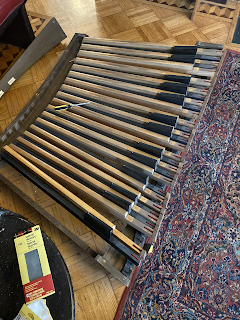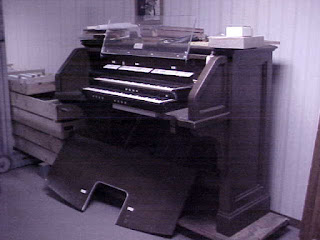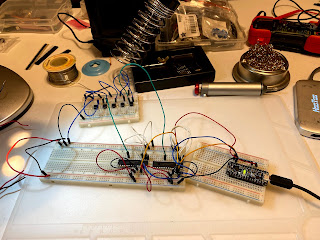plan B
I figured out the wiring, and where I'd want to pick up signal and for my arduino circuit, but the perfection of logic fails in the sad limits of physical reality. The organ is intended to run at a higher voltage - 12 volts or more. This allows the contacts to clean themselves of oxidation. As soon as I clean them and get a good signal, it goes off again. I could run a higher voltage but I'd have to regulate it down to 5 volts over 156 separate wires, so that is getting silly. I could reduce the wires by building a matrix, but no.
Plan B involves scrapping the original keypress detecting circuitry in favor of either reed switches or hall effect sensors. ordered a few and some magnets to test with.
I've read, from people who've done this, that it is easy in the pedals, but in the manuals the magnets get so close together you have to alternate them north/south down the line. I'm not sure how this will affect the south-pole detecting sensors I'm getting, so I'll make a small row and see before ordering tons of them.
Meanwhile, I have opened up the pedalboard and removed all the keys for cleaning. They were musty and dusty, and several of them bound up and barely moved. I'm very happy with the results - they could still use a bit of sanding and refinishing on the tops, but that can wait - they look and smell much better, and the action is nice. The problem with the ones not moving is they just needed a little shimming to sit square to the guide rails. The bottom and top felt could use replacing, but it isn't urgent and the springs are good.
I didn't get a 'before' shot before I took the front rail and a couple of pedals off:
But here it is all cleaned up and sweet:
Next...
Plan B involves scrapping the original keypress detecting circuitry in favor of either reed switches or hall effect sensors. ordered a few and some magnets to test with.
I've read, from people who've done this, that it is easy in the pedals, but in the manuals the magnets get so close together you have to alternate them north/south down the line. I'm not sure how this will affect the south-pole detecting sensors I'm getting, so I'll make a small row and see before ordering tons of them.
Meanwhile, I have opened up the pedalboard and removed all the keys for cleaning. They were musty and dusty, and several of them bound up and barely moved. I'm very happy with the results - they could still use a bit of sanding and refinishing on the tops, but that can wait - they look and smell much better, and the action is nice. The problem with the ones not moving is they just needed a little shimming to sit square to the guide rails. The bottom and top felt could use replacing, but it isn't urgent and the springs are good.
I didn't get a 'before' shot before I took the front rail and a couple of pedals off:
But here it is all cleaned up and sweet:
Next...





Comments
Post a Comment